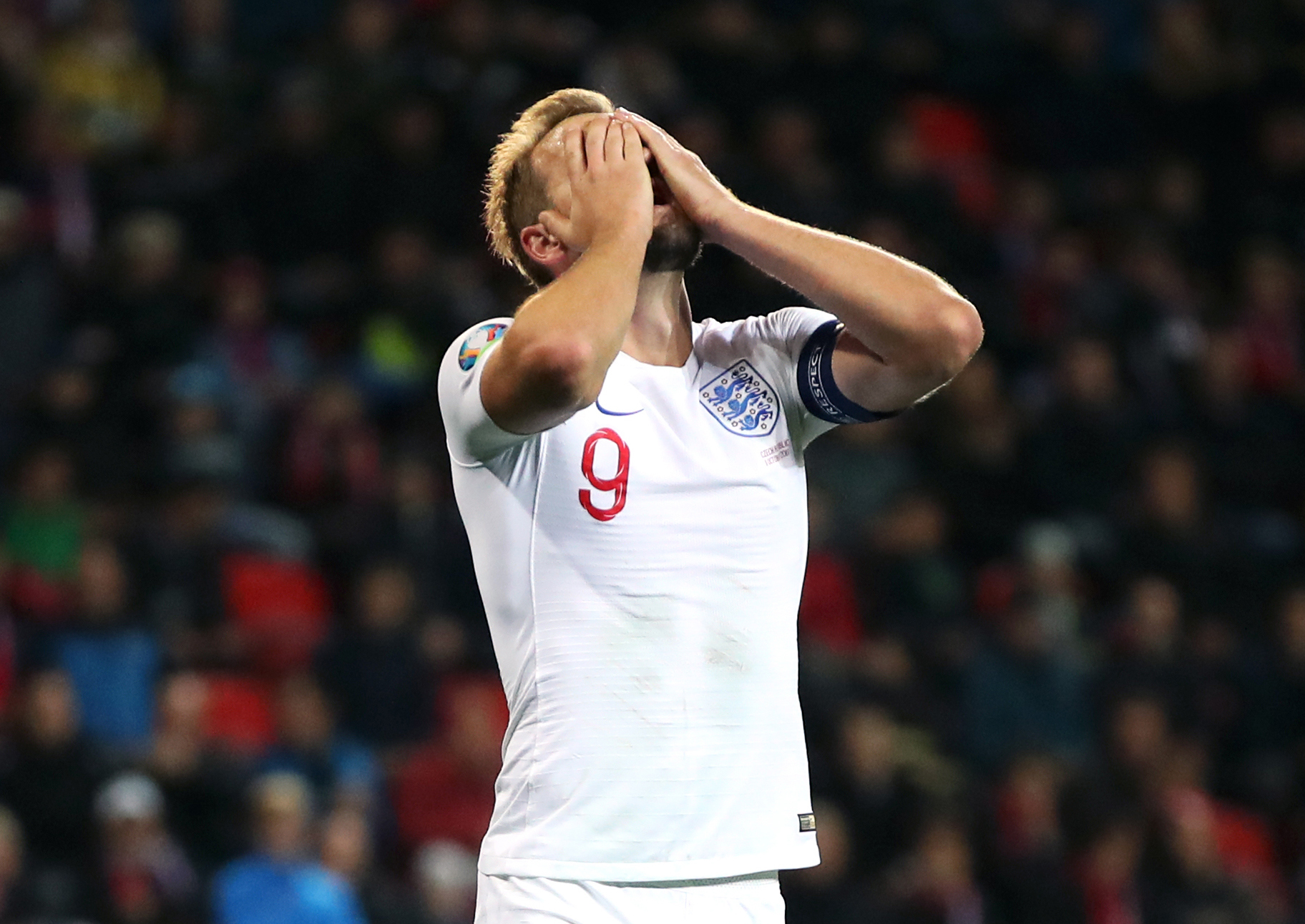Yes, he has scored a lot of goals in Euro qualification, but there’s more to it than that. On 2nd November 2014, Harry Kane scored his first Premier League goal of Mauricio Pochettino's time at Spurs. Since then, the idea that the Tottenham academy graduate is the best English striker around has been as close to a universally held opinion as possible. 109 non-penalty goals in 178 league games is as much as one could reasonably ask. But as the years pass, concern about Kane's actual numbers has grown. Meanwhile, Tammy Abraham has emerged as a viable alternative. Let’s take a closer look at both players.
Kane Concerns
Before we dig into the problems, let’s remember what was probably the best period in Kane’s career, August 2017 to March 2018, during which he scored 22 non-penalty goals across 28.2 90s. 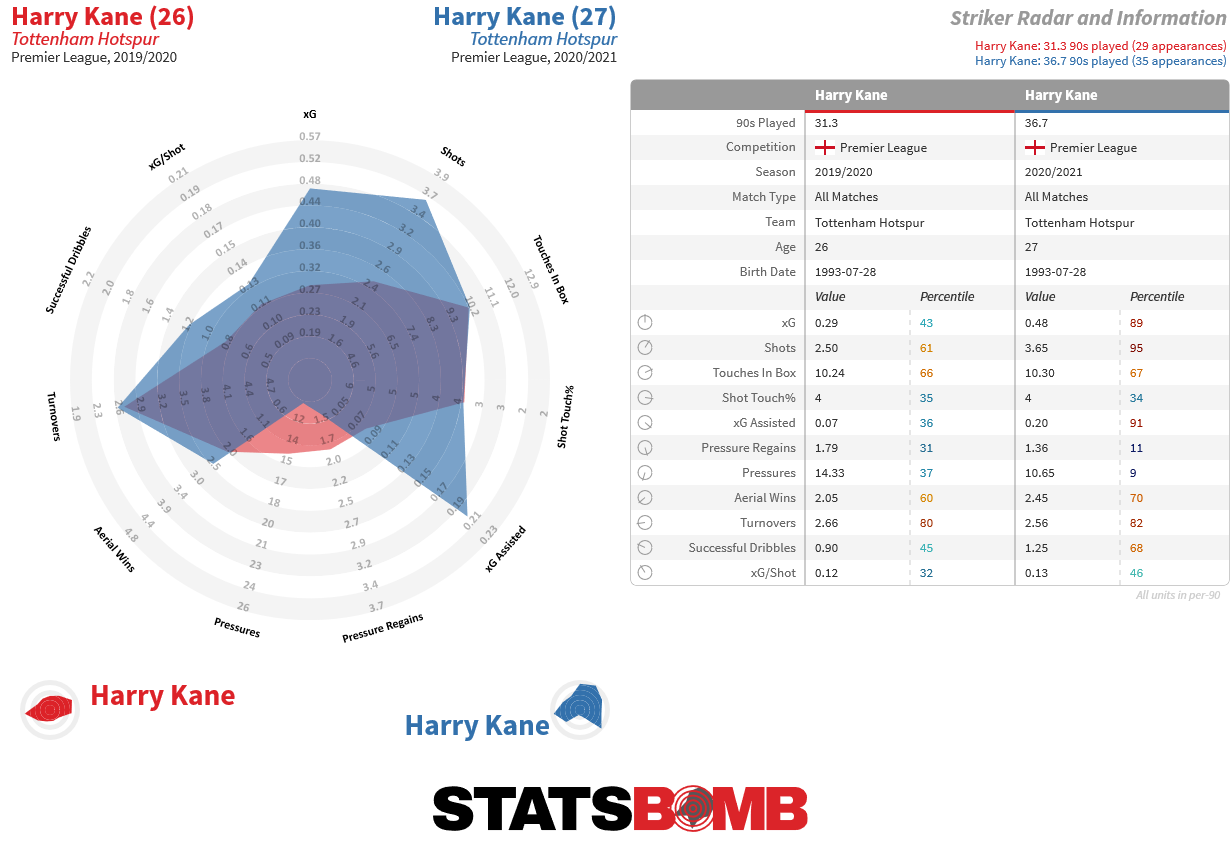 What that stands out visually is how much he prioritised getting shots and scoring goals over other parts of his game. As now-StatsBomb managing editor Mike L. Goodman noted at the time, “Harry Kane isn’t a complete forward. His job isn’t to facilitate play, or bring wingers into the game, or create holes in the defense for his teammates to take advantage of. Tottenham Hotspur’s star striker does one thing: He scores”. And boy did he score.
What that stands out visually is how much he prioritised getting shots and scoring goals over other parts of his game. As now-StatsBomb managing editor Mike L. Goodman noted at the time, “Harry Kane isn’t a complete forward. His job isn’t to facilitate play, or bring wingers into the game, or create holes in the defense for his teammates to take advantage of. Tottenham Hotspur’s star striker does one thing: He scores”. And boy did he score. 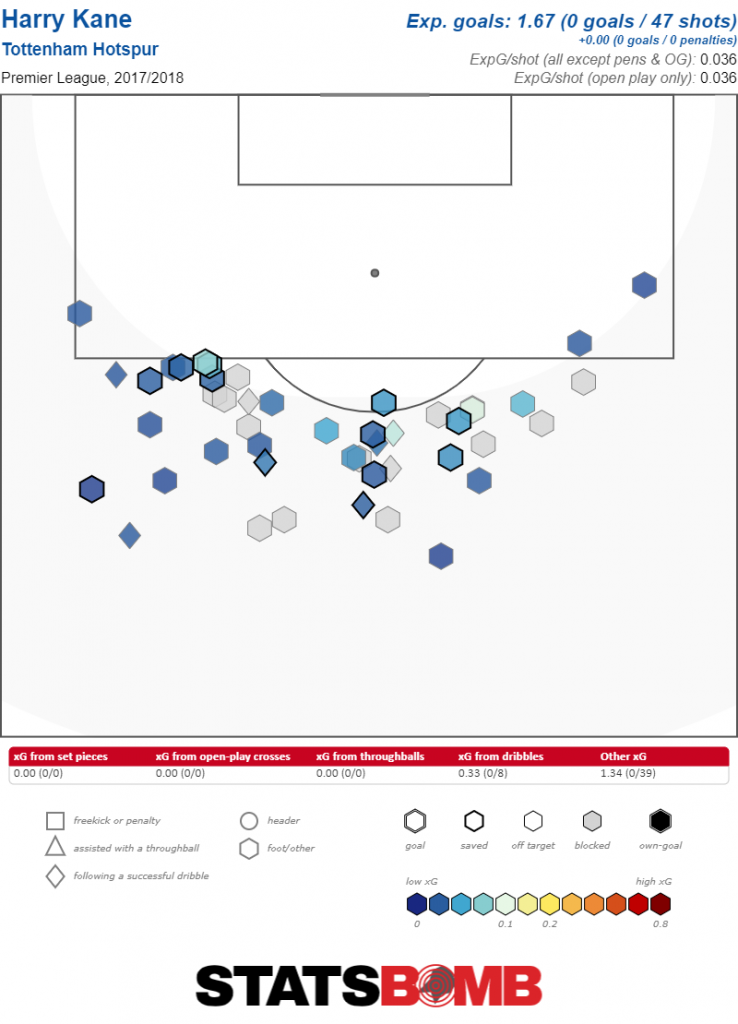 This wasn’t always the case. In previous years, Kane assumed a more well-rounded role, linking up play while sharing the goalscoring burden with Dele Alli and Son Heung-min. But when Kane’s form exploded, everything started to funnel toward him. Spurs were, as Pep Guardiola infamously described them, “the Harry Kane team”. What happened next was rather unfortunate. Kane picked up an ankle injury that kept him out of just two games, but when he returned, it was clear he wasn’t at 100%.
This wasn’t always the case. In previous years, Kane assumed a more well-rounded role, linking up play while sharing the goalscoring burden with Dele Alli and Son Heung-min. But when Kane’s form exploded, everything started to funnel toward him. Spurs were, as Pep Guardiola infamously described them, “the Harry Kane team”. What happened next was rather unfortunate. Kane picked up an ankle injury that kept him out of just two games, but when he returned, it was clear he wasn’t at 100%. 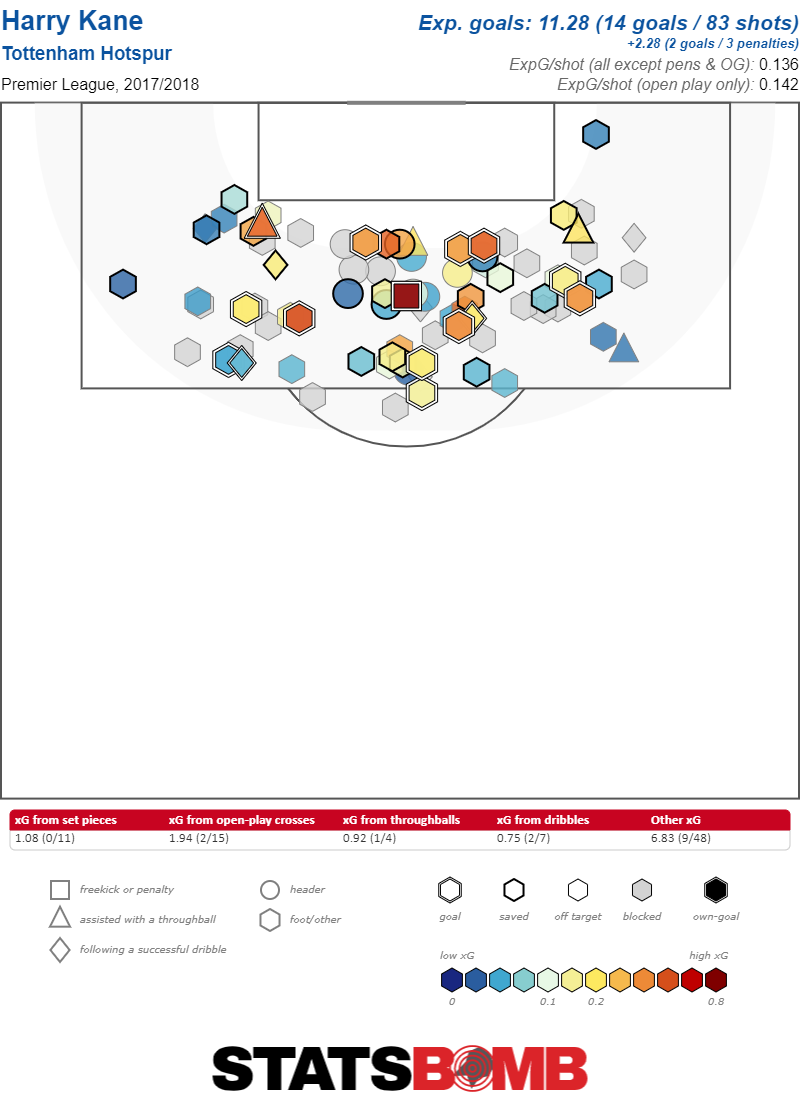 Things improved a touch in 2018-19, but we were still looking at a player performing well below his best.
Things improved a touch in 2018-19, but we were still looking at a player performing well below his best. 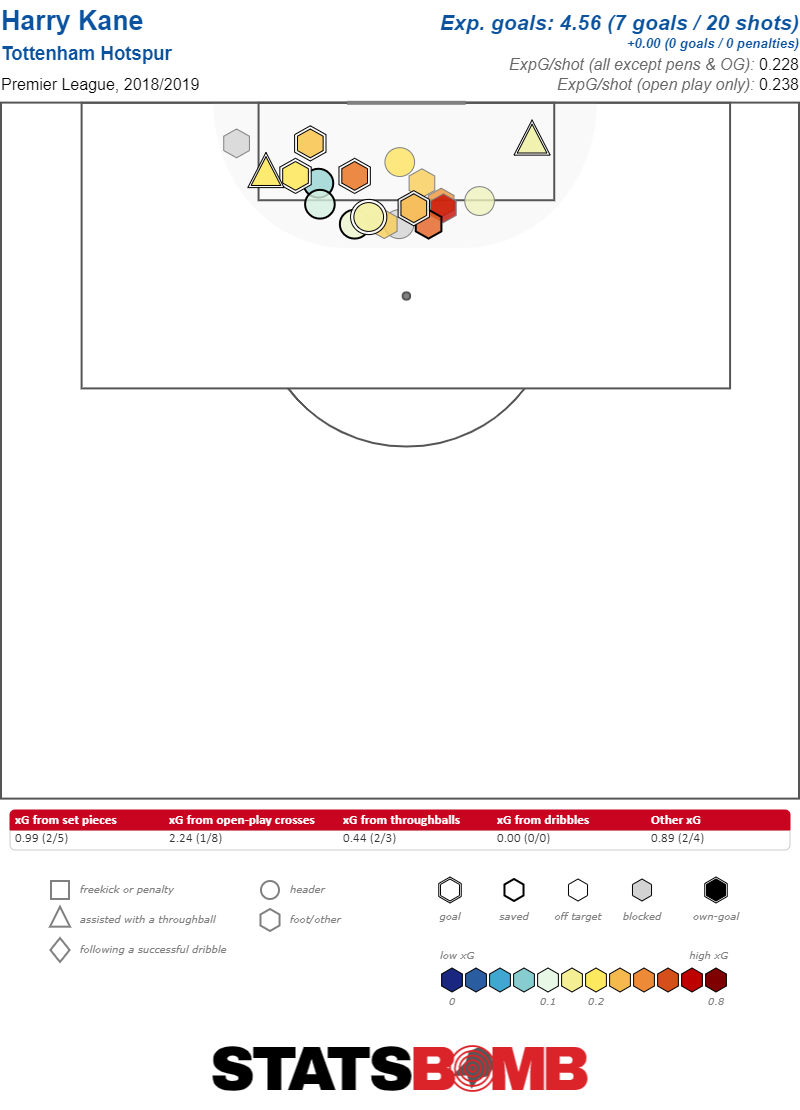 And then we arrive at this season, which just doesn’t look good at all.
And then we arrive at this season, which just doesn’t look good at all. 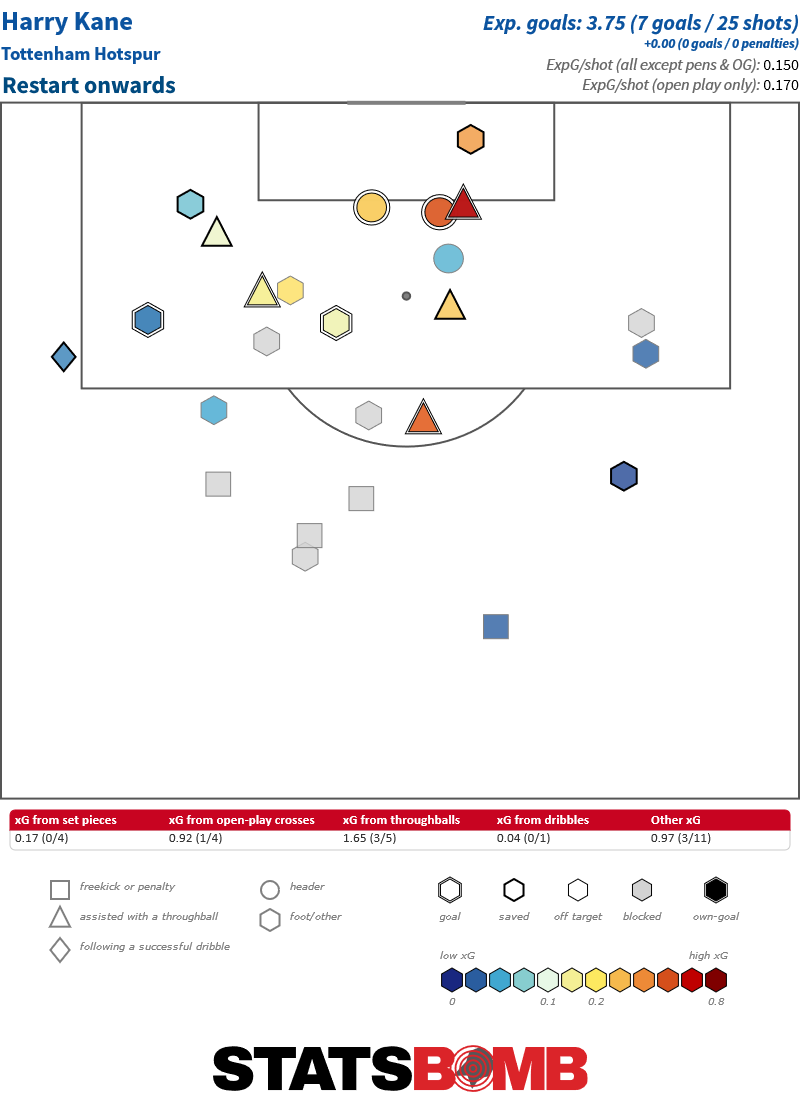 The obvious response is to mention Spurs’ deteriorating form which has now resulted in Pochettino’s departure. And it’s true that form a real factor; it doesn’t take StatsBomb data to tell you strikers benefit from playing in teams that create chances more easily. What we know is that Tottenham’s expected goals in attack have seen a 32.5% decrease this season compared to 2017–18, a sizeable decline to be sure. But Kane’s individual xG and xG assisted has fallen by 53.4% over the same period. The two numbers cannot be separated, but Kane’s attacking output has declined at a faster rate than Spurs overall. We should also note his touches in the box have risen, as he’s become much less efficient at turning them into good shots. It certainly can’t be claimed that this blame falls solely on him, and it definitely feels plausible that his numbers would look better in a stronger side, but it’s also hard to use stats to make a case that Kane is merely a victim of Spurs’ problems, rather than an active contributor to them. The other defence often noted is his England form, with many pointing to Gareth Southgate’s side as an environment where Kane is able to thrive due to the better service he receives. Nine non-penalty goals in just over 1200 minutes since the World Cup is a strong figure, even if it’s generally boosted in the headlines, which include the five penalties he's scored. There is less optimism regarding his shot volume. Unfortunately, we do not have expected goals data here, but we know Kane has taken fewer than three shots per 90 minutes since the 2018 World Cup. Again, we don’t have the xG numbers to back up what we've seen, but unless these shots are exceptionally better than those he generally takes for Tottenham, his goalscoring for England will not continue at this volume.
The obvious response is to mention Spurs’ deteriorating form which has now resulted in Pochettino’s departure. And it’s true that form a real factor; it doesn’t take StatsBomb data to tell you strikers benefit from playing in teams that create chances more easily. What we know is that Tottenham’s expected goals in attack have seen a 32.5% decrease this season compared to 2017–18, a sizeable decline to be sure. But Kane’s individual xG and xG assisted has fallen by 53.4% over the same period. The two numbers cannot be separated, but Kane’s attacking output has declined at a faster rate than Spurs overall. We should also note his touches in the box have risen, as he’s become much less efficient at turning them into good shots. It certainly can’t be claimed that this blame falls solely on him, and it definitely feels plausible that his numbers would look better in a stronger side, but it’s also hard to use stats to make a case that Kane is merely a victim of Spurs’ problems, rather than an active contributor to them. The other defence often noted is his England form, with many pointing to Gareth Southgate’s side as an environment where Kane is able to thrive due to the better service he receives. Nine non-penalty goals in just over 1200 minutes since the World Cup is a strong figure, even if it’s generally boosted in the headlines, which include the five penalties he's scored. There is less optimism regarding his shot volume. Unfortunately, we do not have expected goals data here, but we know Kane has taken fewer than three shots per 90 minutes since the 2018 World Cup. Again, we don’t have the xG numbers to back up what we've seen, but unless these shots are exceptionally better than those he generally takes for Tottenham, his goalscoring for England will not continue at this volume.
Tammy Abraham, the Kane Challenger
Not unlike a younger Kane, the path to the Chelsea first team hasn’t been the most straightforward for Abraham. Both men were sent out on loan at a young age, but while Kane found it difficult, the Chelsea striker thrived, scoring 21 non-penalty goals at the tender age of 19 for Bristol City in the Championship. This unsurprisingly earned him a move up to the Premier League, where things went rather less swimmingly. Six goals over the season is the number that haunts him, though we must consider the mitigating circumstances. Abraham arrived at Swansea after they sold their most obvious creator in Gylfi Sigurdsson, and brought in no one of an even vaguely similar skillset. The team had pure strikers in Abraham and Wilfried Bony but lacked the players to create chances for them. Manager Paul Clement’s dreary defensive football saw Abraham largely isolated upfront. Subsequent boss Carlos Carvalhal had different ideas, but this often involved eschewing a recognised striker altogether. Abraham still managed to put up the best xG per 90 of any under-21 player outside the top six that season, which was probably as much as could reasonably be expected. Someone at Chelsea apparently disagreed with this assessment, though, and decided that Abraham should be demoted back down to the Championship. He scored 20 non-penalty goals for Aston Villa and proved himself one of the better strikers in the division, but to those watching, it felt he wasn’t being really tested. 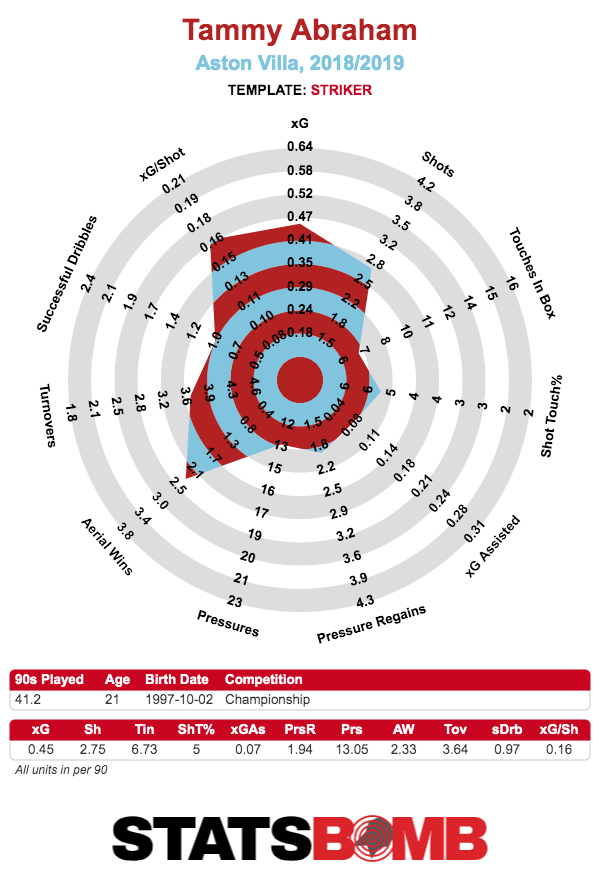 But even the most optimistic arguments in Abraham’s favour couldn’t quite have predicted this season. The goals are the biggest factor, and they’re backed up by plenty of good shots. Whatever questions that may have existed about his all-round game have been blown out of the water. This season, only Sergio Agüero has a bigger xG and xG assisted per 90 numbers in the Premier League.
But even the most optimistic arguments in Abraham’s favour couldn’t quite have predicted this season. The goals are the biggest factor, and they’re backed up by plenty of good shots. Whatever questions that may have existed about his all-round game have been blown out of the water. This season, only Sergio Agüero has a bigger xG and xG assisted per 90 numbers in the Premier League. 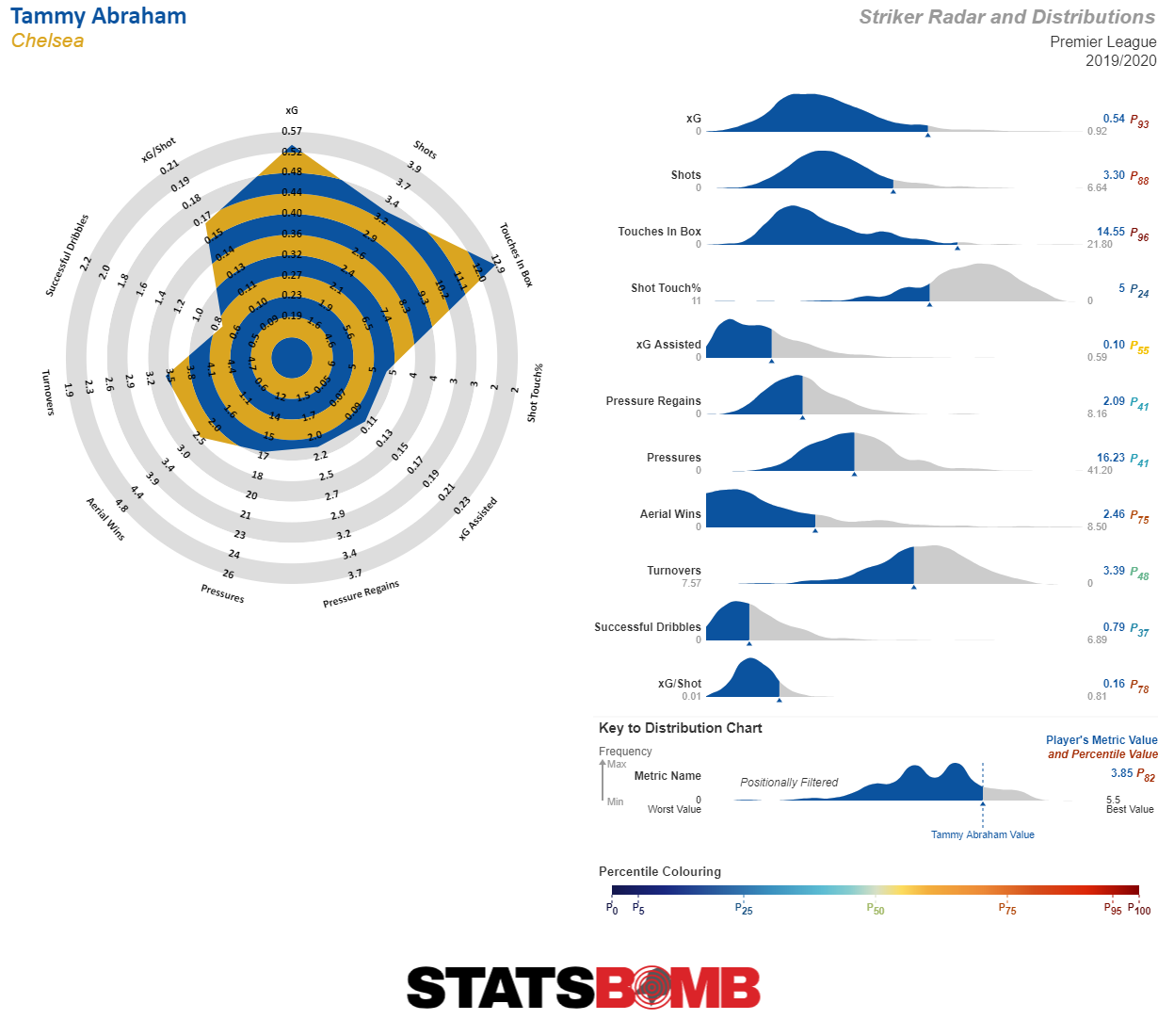 It’s an open question as to whether he can keep this kind of form up across the season. With xG focused analysis, there is a tendency to forget that generating shots is also subject to variance. Abraham’s recent form is above what he's shown in the past, and can be said to be inflated in a number of ways. The gap in the numbers right now is so vast, though, that it’s almost impossible to argue that Kane is currently playing better football than Abraham.
It’s an open question as to whether he can keep this kind of form up across the season. With xG focused analysis, there is a tendency to forget that generating shots is also subject to variance. Abraham’s recent form is above what he's shown in the past, and can be said to be inflated in a number of ways. The gap in the numbers right now is so vast, though, that it’s almost impossible to argue that Kane is currently playing better football than Abraham.
So What do England do?
England will kick off their Euro 2020 finals campaign at Wembley on 14 June and, if fit, it seems almost certain Southgate will select Kane up front. Other personnel questions remain, but several things seem to be clear in his mind: The default formation will be 4-3-3, and the core of the attack will be built around Kane dropping deeper into “false nine” positions to allow Rahee\ Sterling and another wide forward to exploit the space behind. As much as Kane’s form has become a significant talking point in the tiny bubble of the football analytics community, it hasn’t made much of a dent in the wider world, where the perception remains that the England captain is one of the undisputed best strikers around. There’s scant evidence that Southgate doesn’t share the more popular view. But should he change his mind? A tactical idea Frank Lampard is working on at Chelsea should give him pause. Increasingly, the Chelsea wingers run past Abraham into more explicit poaching zones right in front of goal. It had already been reported that Lampard was using none other than England star Sterling as a reference point for the runs he wants his wingers to make, and he as much as confirmed it himself, stating that “what Raheem Sterling’s made his own into the last couple of seasons is getting in [the six-yard box] and I love that Christian [Pulisic] goes all the way in there”. As Lampard prompts his wingers to take up more Sterling-esque positions, he seems to be encouraging Abraham to adapt, as (unusually) the striker has not yet taken a shot inside box, unlike his wide counterparts. If this trend continues, there’s no reason to think Abraham would not be able to thrive in an England system built around Sterling. Perception can be a curious thing in football. Through his good finishing, penalties and distribution of goals that has enabled him to avoid any prolonged “dry spells”, Kane has maintained an image as one of Europe’s elite strikers despite no longer having the numbers to back it up. This can’t last forever; eventually, Kane will need to close the gap in terms of taking good shots in order to avoid Abraham succeeding him as England’s best striker. Header image courtesy of the Press Association
